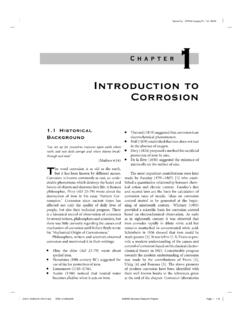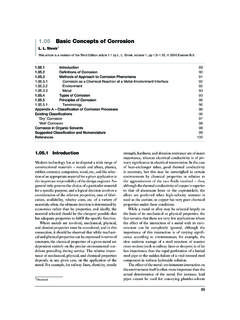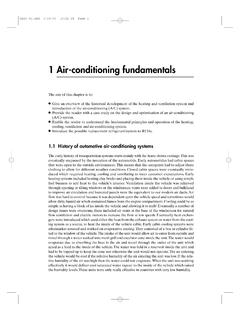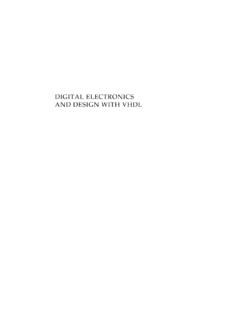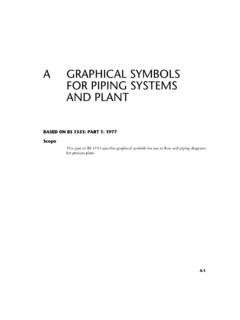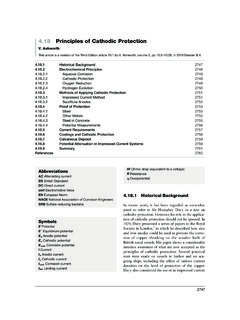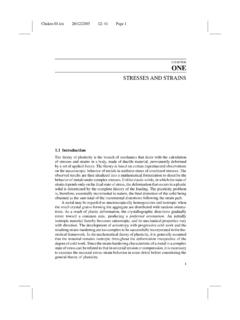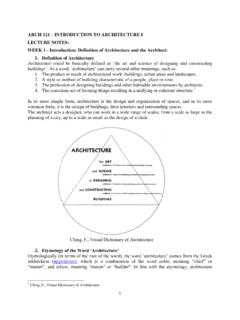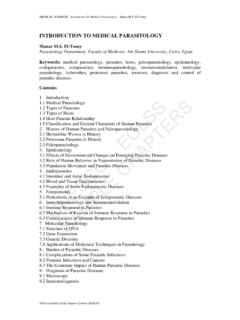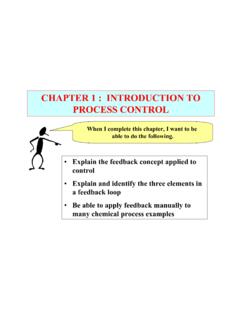Transcription of Automotive Fundamentals - Elsevier.com
1 Automotive FundamentalsPicture yourself in the not-too-distant future driving your new car alonga rural interstate highway on a business trip. You are traveling along one of thenew automated highways in which individual cars are controlled electronicallyto maintain a fixed spacing in a lane at a preferred speed. Typically, these carsare traveling at 70 mph and are spaced about 25 ft apart. The cars are computercontrolled via a digital communication link, including a cable buried in thecenter of the cruise lane and follow one another in a pattern known asplatooning. Your car will automatically remain in this cruise control lane untilyou approach your destination press a button on the steering column and an image of a road mapappears faintly visible (so as not to obscure the road ahead) on the windshieldin front of you. This map shows your present position and the position of thedestination city.
2 The distance to your destination and the approximate arrivaltime are displayed on the digital instrument are talking on your cellular phone to your office about some changesin a contract that you hope to negotiate. You are wearing a lightweight headsetthat enables you to use the cell phone hands free to drive. Dialing is accom-plished by voice command using voice recognition software in your cell phonecontroller. After the instructions for the contract changes are completed, aprinter in your car generates a copy of the latest contract spouse (in the passenger seat) is sending e-mail messages using theon-board computer that is linked by radio to the Internet. Your son (in the rearseat) is watching a movie via an interactive digital link, while your daughter(also in a rear seat) is doing a math lesson from an education center with aninteractive video you finish your phone call, the onboard entertainment system startsplaying music for you at a comfortable level relative to the low-level wind androad noise in the car.
3 After completing your phone conversation, you pressanother button on the steering wheel and the music is replaced by a recordedlesson in French verb conjugation, which you have been studying. Suddenly,the French lesson is interrupted by a message delivered in natural-soundingsynthesized speech. You have fuel remaining for another 50 miles at thepresent speed. Your destination is 23 miles away. Recommend refueling afterexiting the highway. There is a station that accepts your electronic credit nearthe exit (you know, of course, that the electronic credit is activated by insertingthe fuel nozzle into the car). Also, the left rear tire pressure is low and theengine control system reports that the mass air flow sensor is intermittentlymalfunctioning and should be serviced soon. After this message has beendelivered, the French lesson FUNDAMENTALS1 UNDERSTANDING Automotive 2003 Elsevier ScienceAll rights short time later, the French lesson is again interrupted by the electronicvoice message system: Replace the disk in the Navigation CD player with disknumber 37 for detailed map and instructions to your destination, please.
4 Then the French lesson insert the correct disk in the Navigation CD player as requested andthe map display on the windshield changes. The new display shows a detailedmap of your present position and the route to your destination. As youapproach the city limits, the car speed is automatically reduced to the legallimit of 55 mph. The voice message system speaks again: Leave the highway atexit 203, which is one-half mile away. Proceed along Austin Road to thesecond intersection, which is Meyer Road. Turn right and proceed destination is on the right-hand side of the road. Don t forget to refuel. This scenario is not as farfetched as it sounds. All of the events describedare technically possible. Some have even been tested experimentally. Theelectronic technology required to develop a car with the features describedexists today.
5 The actual implementation of such electronic features will depend on the cost of the equipment and the market acceptance of OF ELECTRONICS IN THE AUTOMOBILEFor most people, the automobile has come to be an appliance. It isarguably the most cost effective, most user friendly of appliances availabletoday. The personal computer industry likes to refer to its products as userfriendly. However if the automobile had the same user friendliness as a PC, itwould arrive in six or more large boxes and require the owner to install theengine wheels and seats and load the programs into its various electronicsystems and the documentation would be unreadable. Moreover, in use itwould break down every 100 or so miles. This comparison is offered tongue in cheek, but it does illustrate the relatively high reliability of modernautomobiles with their various electronic subsystems.
6 Although its utility isprimarily for transportation, the new automobile electronics can give it a broad range of auxiliary capabilities, as will be illustrated in this OF Automotive ELECTRONICSE lectronics have been relatively slow in coming to the automobileprimarily because of the relationship between the added cost and the , the first electronics (other than radio) were introduced into thecommercial automobile during the late 1950s and early 1960s. However, thesefeatures were not well received by customers, so they were discontinued fromproduction FUNDAMENTALS2 UNDERSTANDING Automotive ELECTRONICSM icroelectronics will provide many excit-ing new features for 2003 Elsevier ScienceAll rights major events occurred during the 1970s that started the trendtoward the use of modern electronics in the automobile: (1) the introductionof government regulations for exhaust emissions and fuel economy, whichrequired better control of the engine than was possible with the methods beingused; and (2) the development of relatively low cost per function solid-statedigital electronics that could be used for engine control and other are being used now in the automobile and probably will beused even more in the future.
7 Some of the present and potential applicationsfor electronics are1. Electronic engine control for minimizing exhaust emissions andmaximizing fuel economy2. Instrumentation for measuring vehicle performance parameters and fordiagnosis of on-board system malfunctions3. Driveline control4. Vehicle motion control5. Safety and convenience6. Entertainment/communication/navigationMa ny of these applications of electronics will be discussed in this OVERVIEWThis chapter will give the reader a general overview of the automobilewith emphasis on the basic operation of the engine, thus providing the readerwith the background to see how electronic controls have been and will beapplied. The discussion is simplified to provide the reader with just enoughinformation to understand Automotive mechanics. Readers who want to knowthe mechanics of an automobile in more detail are referred to the many bookswritten for that AUTOMOBILE PHYSICAL CONFIGURATIONThe earliest automobiles consisted of carriages (similar to those drawn byhorses) to which a primitive engine and drivetrain and steering controls wereadded.
8 Typically, such cars had a strong steel frame that supported the body ofthe car. The wheels were attached to this frame by a set of springs and shockabsorbers that permitted the car to travel over the uneven road surfaces of theday while isolating the car body from many of the road irregularities. Thissame general configuration persisted in most passenger cars until some timeafter World War II, although there was an evolution in car size, shape, andfeatures as technology permitted. Beginning in the late 1960s, governmentregulations imposed severe design constraints on automobiles that led (as willbe shown) to an evolution of electronic systems in Automotive design. It is thisevolution that is the primary focus of this FUNDAMENTALS1 UNDERSTANDING Automotive ELECTRONICS3 Environmental regula-tions and an increasedneed for economy haveresulted in electronicsbeing used within anumber of 2003 Elsevier ScienceAll rights the remainder of this chapter, the basic automobile components andsystems are reviewed as they pertained to the post World War II, preemissions-control era.
9 This review provides a framework within which the present dayautomobile with its extensive use of electronics can be understood. In thissense, the motivation for applying electronics to solve regulatory problemsimposed on the industry can readily be seen. Readers with a solid backgroundin basic Automotive systems may want to skip the remainder of the early configuration is depicted in Figure , in which many of theimportant Automotive systems are illustrated. These systems include thefollowing:1. Engine2. Drivetrain (transmission, differential, axle)3. Suspension4. Steering5. Brakes6. Instrumentation7. Electrical/electronic8. Motion control9. Safety10. Comfort/convenience11. Entertainment/communication/navigationIn Figure the frame or chassis on which the body is mounted issupported by the suspension system.
10 The brakes are connected to the oppositeend of the suspension components. The steering and other major mechanicalsystems are mounted on one of these components and attached as necessarythrough mechanical components to other basic vehicle configuration was used from the earliest cars throughthe late 1960s or 1970s, with some notable exceptions. The increasingimportance of fuel efficiency and government-mandated safety regulations ledto major changes in vehicle design. The body and frame evolved into anintegrated structure to which the power train, suspension, wheels, etc., again with a few notable exceptions, most cars had an engine in afront configuration with the drive axle at the rear. There are advantages inhaving the engine located in the front of the vehicle ( , crash protection,efficient engine cooling). Until recently, the so-called drive wheels throughwhich power is delivered to the road have been the rear wheels (as depicted inFigure ).
